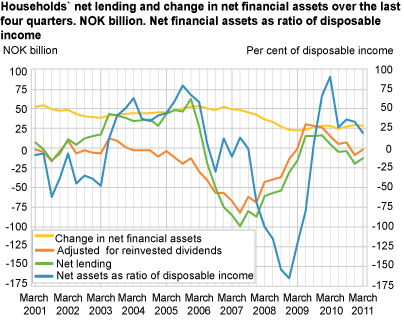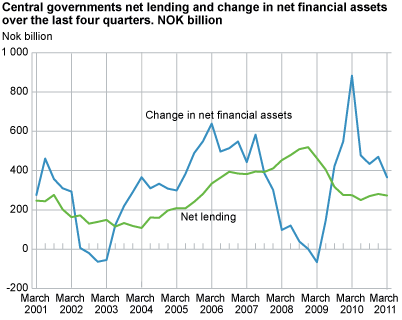Content
Published:
This is an archived release.
Net lending stops falling
The decreasing development in households and non-profit institutions serving households’ net lending has come to a temporary stop. In the last four quarter period, households increased their bank deposits and investments in shares.
Households’ net lending is calculated to NOK -13 billion in the four quarter period to the first quarter 2011. This is up NOK 6.5 billion from the previous four quarter period, which summarises the year 2010. Households’ net lending showed a decreasing development in the four previous four quarter periods from the fourth quarter of 2009 to the fourth quarter of 2010.
Household increases borrowing from financial corporations
In the four quarter period to the first quarter of 2011, households’ borrowing has been NOK 144 billion. This implies a growth in debts of 6.5 per cent, which is 0.1 percentage point higher compared to the previous four quarter period. Lending from financial corporations to households increased by almost NOK 9 billion to NOK 132 billion, but other accounts payable have moderated households’ total borrowing in the last four quarter period. Investments in financial assets amounted to NOK 131 billion, which is up NOK 9 billion from the previous four quarter period. The development is explained by growth in bank deposits, investments in quoted shares and net acquisition of mutual fund shares. In total, households invested NOK 8 billion in listed securities in the four quarter period to the first quarter 2011. This is up NOK 5 billion compared to the previous period.
Households’ net financial assets increased by NOK 19 billion in the last four quarter period. Net financial assets are estimated to NOK 348 billion at the end of the first quarter of 2011 and constituted 78 per cent of net financial assets at the end of the second quarter of 2007, before financial turmoil and the financial crisis caused large net holding losses.
State’s net financial assets increase
Central government’s net financial assets increased to a new preliminary top level at the end of the first quarter of 2011. The development is explained by both net lending and net holding gains. Net lending in the four quarter period to the first quarter of 2011 was NOK 273 billion. Together with net holding gains of NOK 94 billion, this contributed to increasing the central government’s net financial assets by NOK 366 billion in the last period. Exchange rate developments in foreign exchange in the first quarter of 2011 moderated the value of foreign financial assets. The state’s net financial assets summarised to NOK 4 319 billion at the end of the quarter.
Stable debt development in local government
Local government’s net lending shows a modest improvement in the first quarter of 2011 and is quantified to NOK -16 billion. The development is explained by a moderate fall in borrowing. Local government’s debt stabilised at end-2007, but has increased gradually since then. The local government borrowed NOK 46 billion in the last four quarter period and total debt amounted to NOK 442 billion at the end of the first quarter of 2011. Investments in financial assets amount to NOK 30 billion in the four quarter period to the first quarter of 2011. This is about the same level as in the two previous four quarter periods.
Net holding losses abroad in the first quarter of 2011
Norway’s net foreign assets were calculated to NOK 2 392 billion at the end of the first quarter of 2011. This is up by NOK 51 billion from the end of the fourth quarter of 2010. Norway’s net lending abroad was NOK 72 billion in the first quarter of 2011, which is down by NOK 14 billion from the fourth quarter of 2010. Net holding losses due to exchange rate developments in foreign exchange and global security markets reduced the value of net financial assets abroad by NOK 22 billion in the first quarter of 2011.
| 4. quarter 2008 | 1. quarter 2009 | 2. quarter 2009 | 3. quarter 2009 | 4. quarter 2009 | 1. quarter 2010 | 2. quarter 2010 | 3. quarter 2010 | 4. quarter 2010 | 1. quarter 2011 | ||||||||||||||||||||||||||||||||||||||||||||||||||||||||||||||||||||||
|---|---|---|---|---|---|---|---|---|---|---|---|---|---|---|---|---|---|---|---|---|---|---|---|---|---|---|---|---|---|---|---|---|---|---|---|---|---|---|---|---|---|---|---|---|---|---|---|---|---|---|---|---|---|---|---|---|---|---|---|---|---|---|---|---|---|---|---|---|---|---|---|---|---|---|---|---|---|---|---|
| Financial assets | 6 452 | 5 972 | 6 159 | 6 154 | 6 149 | 6 466 | 6 794 | 6 733 | 6 941 | 7 151 | |||||||||||||||||||||||||||||||||||||||||||||||||||||||||||||||||||||
| Liabillities | 4 918 | 4 603 | 4 452 | 4 264 | 4 261 | 4 379 | 4 614 | 4 482 | 4 600 | 4 759 | |||||||||||||||||||||||||||||||||||||||||||||||||||||||||||||||||||||
| Net financial assets / net financial wealth | 1 535 | 1 370 | 1 708 | 1 890 | 1 889 | 2 087 | 2 179 | 2 251 | 2 342 | 2 392 | |||||||||||||||||||||||||||||||||||||||||||||||||||||||||||||||||||||
| Change in net financial assets / net financial wealth | 114 | -165 | 338 | 182 | -1 | 198 | 92 | 72 | 90 | 51 | |||||||||||||||||||||||||||||||||||||||||||||||||||||||||||||||||||||
| Other changes | -8 | -206 | 257 | 119 | -89 | 114 | 19 | 7 | 4 | -22 | |||||||||||||||||||||||||||||||||||||||||||||||||||||||||||||||||||||
| Net lending | 122 | 41 | 81 | 63 | 88 | 84 | 74 | 65 | 86 | 72 | |||||||||||||||||||||||||||||||||||||||||||||||||||||||||||||||||||||
DefinitionsNet lending as defined in non - financial accounts ( capital account ) = savings + net capital transfers - net acquisition of non - financial assets Net lending as defined in financial accounts = net acquisition of financial assets - net incurrence of liabilities Savings is non-consumed income and can be invested in financial or non-financial assets. If savings exceed non-financial investments, a sector has a surplus of funds and becomes a net lender to other sectors. In the financial transaction account, this means that the sector acquires more financial assets than liabilities. On the other hand, if savings are less than non-financial investments, investments have to be funded either by selling financial assets or incurring debts. Household investments in non-financial assets mainly reflect the purchase of new housing and fixed investments by unincorporated enterprises. They typically finance substantial parts of these investments by incurring debt in the form of loans. Net financial assets ( net financial wealth ) = total financial assets - total liabilities The financial balance sheet shows the financial position of a sector at the end of the reference period and is broken down into the categories of financial assets and liabilities. Insurance technical reserves, currency and deposits are the predominant assets held by households, while loans provided by financial corporations (banks etc.) constitute the main proportion of liabilities. Changes in net financial assets = net lending + other changes in assets , net The change in the financial balance sheet during the reference period is a result of accumulated financial transactions and other changes in assets. The latter category mainly reflects revaluations due to changes in market prices of financial instruments. |
Contact
-
Torbjørn Cock Rønning
E-mail: torbjorn.cock.ronning@ssb.no
tel.: (+47) 97 75 28 57
-
Jon Ivar Røstadsand
E-mail: jon-ivar.rostadsand@ssb.no
tel.: (+47) 21 09 43 69
-
Marit Eline Sand
E-mail: marit.sand@ssb.no
tel.: (+47) 40 90 26 74


